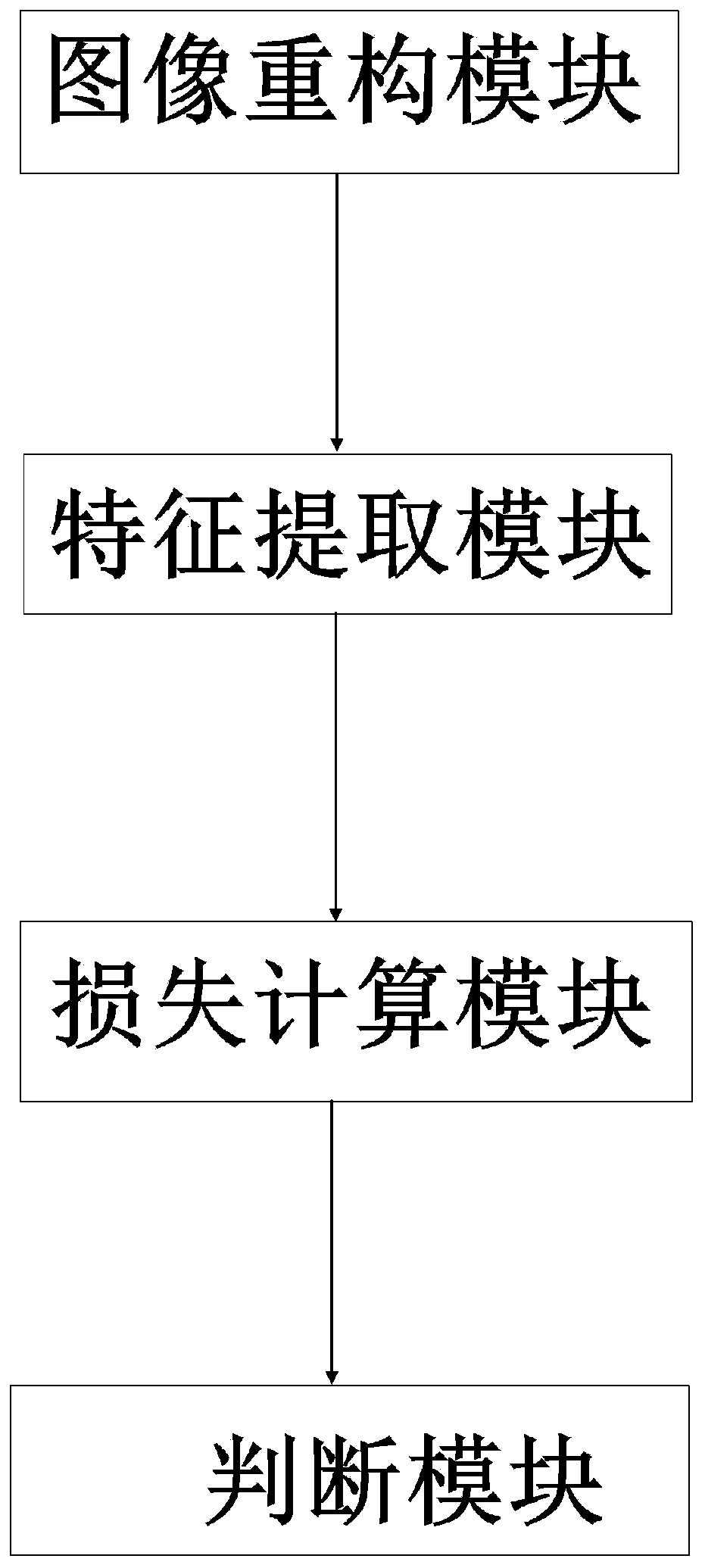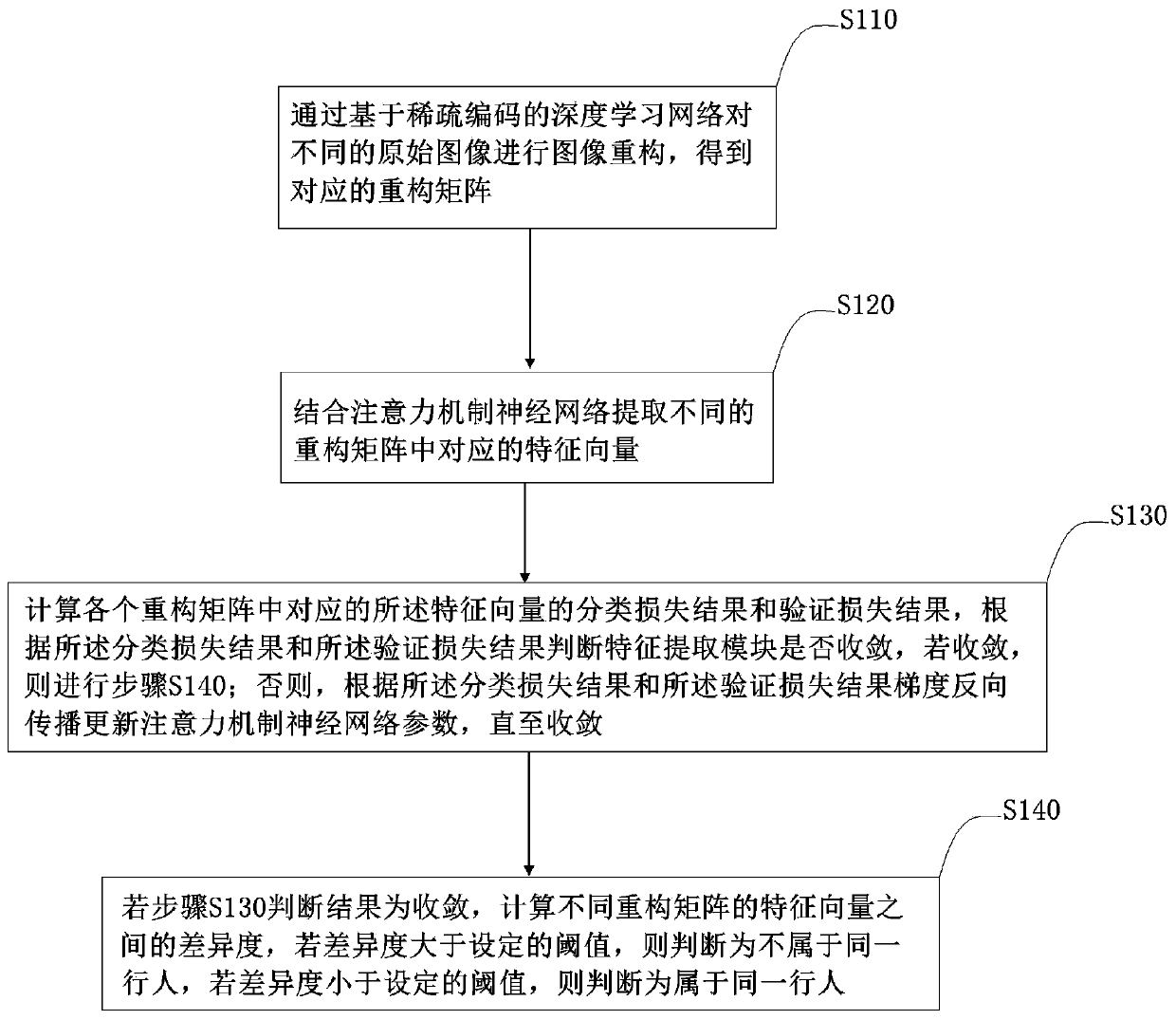Pedestrian re-identification system and method
A pedestrian re-identification and pedestrian technology, applied in the field of pedestrian re-identification, can solve the problems of low accuracy rate, low re-identification accuracy rate, unclear pedestrian outline, etc., to improve accuracy rate, improve image clarity, and improve feature representation ability and the effect of discriminative ability
- Summary
- Abstract
- Description
- Claims
- Application Information
AI Technical Summary
Problems solved by technology
Method used
Image
Examples
Embodiment 1
[0043] Such as figure 2 As shown, Embodiment 1 of the present invention provides a pedestrian re-identification system, which includes:
[0044] The image reconstruction module is used to perform image reconstruction on different original images through a deep learning network based on sparse coding to obtain a corresponding reconstruction matrix;
[0045] The feature extraction module is used to extract the corresponding feature vectors in different reconstruction matrices in combination with the attention mechanism neural network;
[0046]The loss calculation module is used to calculate the classification loss results and verification loss results of the corresponding feature vectors in each reconstruction matrix, judge whether the feature extraction module converges according to the classification loss results and the verification loss results, and if converged, then Send the corresponding feature vectors in each reconstruction matrix to the judgment module; otherwise, up...
Embodiment 2
[0065] Embodiment 2 of the present invention provides a pedestrian re-identification method based on image reconstruction, attention mechanism and multi-task loss function, which is used to judge whether the images acquired by different cameras belong to the same individual.
[0066] Specifically, the system described in Embodiment 2 of the present invention uses the twin network structure in deep learning to input two different images of pedestrians, uses the pedestrian features obtained through the twin network for testing, calculates the feature distance, and judges whether the pedestrian in the corresponding image Whether the pedestrians belong to the same pedestrian.
[0067] The Siamese network consists of two parts, a parameter-sharing reconstruction network and a parameter-sharing attention network. The reconstruction network uses a deep learning network based on sparse coding, which can obtain more image detail information by reconstructing the image. The attention n...
Embodiment 3
[0083] Such as Figure 5 As shown, Embodiment 3 of the present invention provides a method for re-identifying pedestrians using the system described in Embodiment 2. The method includes the following process steps:
[0084] Step 1: Before the image is input to the network, image preprocessing is performed. Including adjusting the image to a fixed size, removing the mean value, and setting the method of randomly selecting input image sample pairs.
[0085] Step 2: The preprocessed image is first input to the image reconstruction module, and the reconstruction network in this module is used to reconstruct the input image to obtain its reconstruction matrix.
[0086] Step 3: The reconstruction matrix obtained in step 2 (that is, the reconstruction module) is input into the attention module, and the attention network is propagated forward to extract the feature vector of the reconstruction matrix.
[0087] Step 4: Input the feature vector of each image obtained in step 3 into th...
PUM
 Login to View More
Login to View More Abstract
Description
Claims
Application Information
 Login to View More
Login to View More - R&D
- Intellectual Property
- Life Sciences
- Materials
- Tech Scout
- Unparalleled Data Quality
- Higher Quality Content
- 60% Fewer Hallucinations
Browse by: Latest US Patents, China's latest patents, Technical Efficacy Thesaurus, Application Domain, Technology Topic, Popular Technical Reports.
© 2025 PatSnap. All rights reserved.Legal|Privacy policy|Modern Slavery Act Transparency Statement|Sitemap|About US| Contact US: help@patsnap.com



